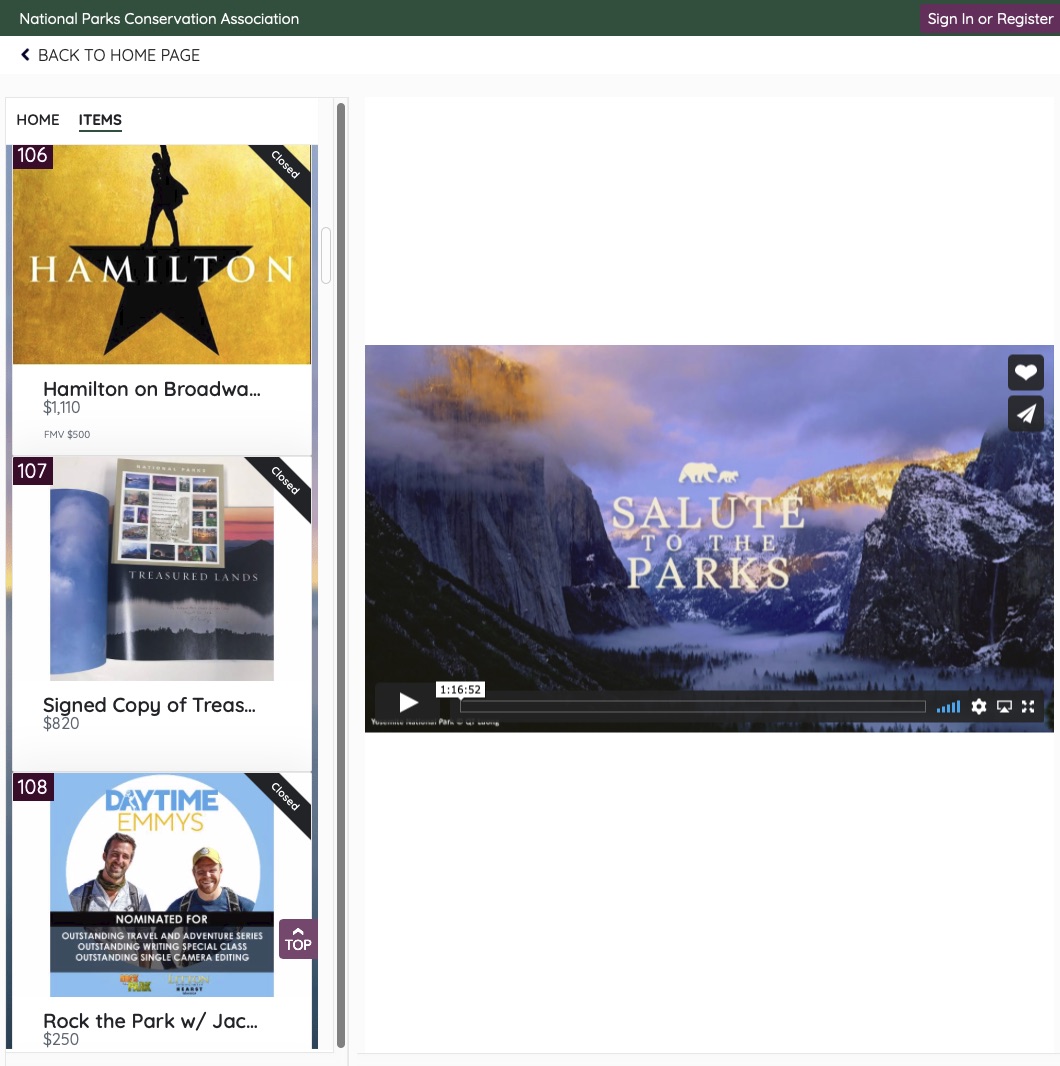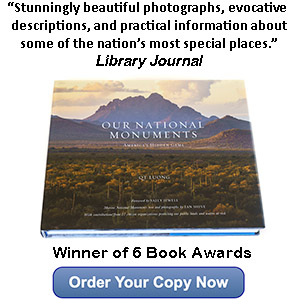Location sharing & Our National Monuments surveys results

Location sharing
Treasured Lands set a precedent for information sharing, but the national monuments are lands with very different rules of engagement from the national parks. Although the Organic Act of 1916 assigned dual missions of conservation and recreation to the National Park Service, it can be argued that the idea of parks “for the benefit and enjoyment of the people” (as found in the law establishing Yellowstone National Park and written on the Yellowstone Arch) came first, with their preservation serving the goal to “leave them unimpaired for the enjoyment of future generations.” Stephen Mather, the man responsible for the creation of the National Park Service, and its first director, envisioned them as places of mass tourism, and there are few strategies he passed over in order to attract more visitors – the constituency for the fledging parks. By contrast, the national monuments are for conservation. The absence of infrastructure means no trash cans, restrooms, boardwalks, or paved trails that help reduce impact. Also lacking is the “soft infrastructure” of rangers. Compared to national parks, they are generally less developed, accessible, popular, or documented. The poll appeared in this post about location sharing.


Readers who answered the poll share my concern in publicizing locations such as those often found in national monuments. For inclusion of locations or directions, I made a judgment based on resilience to visitation for places ranging from well-publicized places already mentioned in guidebooks to personal finds. Eventually, all locations selected felt into the “already documented” category – although that doesn’t mean you’ve heard of them already! I generally excluded locations not mentioned either by the managing agency or a conservation organization dedicated to the monument. For each of the monuments, I have tried to consult with such an organization and asked if they had objections over my write-up. There was none, and an organization director even told me that the places they recommend to visitors are exactly the ones I listed – without prior coordination. I trust that people who actually care for the lands would know best.
Petroglyph or pictograph sites are found in almost each of the national monuments in the book. However, vandalism is a particular concern, so I have been selective in mentioning them or in providing directions, even though a former conservation organization president lists GPS coordinates for specific panels. For instance, while researching Rio Grande Del Norte National Monuments, I found out about petroglyphs located close to a well-known trail. They turned out to be quite remarkable, but when chatting with a volunteer, I learned that they had purposely refrained from putting trail signage for the petroglyphs. I didn’t include a picture nor mentioned those petroglyphs in the book.
Information in the book
When I conceived Treasured Lands, many in the book industry were skeptical that I could produce a combined art book and (somewhat) guidebook, but the art director Iain Morris found a way to make it work by separating the pictures and information. Maybe I wasn’t clear enough when I wrote that Our National Monuments uses the same format as Treasured Lands. If there were no information pages, there would be none of the things that were more popular such as “Info: natural history” or and “Author’s experience”.

Besides that misunderstanding, my plan for the book was mostly in agreement with the readers’ interests. There was already a lot of information about the national parks, so my writing on the information pages of Treasured Lands emphasized the “Photographic odyssey” aspect, and someone reading them cover-to-cover could learn quite a bit about landscape photography. On the other hand, there is little published information about the national monuments. Our National Monuments is the first photography book dedicated to them, and if published only two months earlier, would also have been the first national monuments “guidebook”. Therefore, I wanted the text to be mostly about the national monuments and to educate readers about what makes them so special.
Although I have tried my best, I realized that there were people certainly more qualified than me: the “Friends” groups, aka conservation organizations made of local grassroots activists that advocate for those lands, help protect and popularize them, and in many cases were instrumental in the establishment of those national monuments. Conservation starts with community. Places are best protected when a group of local citizens leads the advocacy efforts. I am immensely grateful and honored that a citizen organization has accepted to lend its voice to each of the 27 national monuments in the book. Besides contributing the essays, many have helped plan trips or offered comments that improved this book. The only difference in design with Treasured Lands is that to accommodate their longer essays, the opening page for each national monument is text only. To see pages of the book, head to OurNationalMonuments.com.
In building a constituency for any lands, there is always a balance to be struck while making information available. The editor I hired for this project had a prominent role in conservation. An overwhelming majority (85%) plan to use the information for travel planning, but only a minority (45%) thought the “practical aspect” was more important than “interesting to read”. A majority (67%) expressed interest in an electronic version. That, with the votes on topics, convinced me to prepare two slightly different versions of the information pages, one for print, and the other for electronic distribution. Unlike for Treasured Lands for which the text was identical, the PDF will be expanded with practical details such as directions.
About that subtitle
Selecting the title was relatively easy. I eventually preferred “Our” to “The” or “America’s” to emphasize how those public lands belong to every American. I liked the echo of John Muir’s Our National Parks (1901), the first book about the national parks.From the beginning, the working title for my project had been “monuments at risk”, which was logical because the project originated as my reaction to the previous administration’s attack on the national monuments. Therefore, for the subtitle, my first thought was to emphasize that aspect with words like “at risk, endangered, under threat”. However, my distributor warned me that this carried negative overtones that could hurt book sales. It turned out that readers also agreed in round one since none of those subtitles were popular at all.

A second idea was to emphasize another character of those lands with the words “less traveled, unknown, undiscovered, overlooked, unseen”. My wife quickly suggested “The Parks Less Traveled” in that vein. I thought it was descriptive and intriguing at the same time. Intriguing with the wit and poetic reference to Robert Frost’s The Road Not Taken. Descriptive with the suggestion that those are lands similar to the national parks, and the fact that of all the five, “less traveled” is the most accurate. However, it was brought out that the word “less” is a tough sell in a title because of the implication, even subconscious, that these lands are lesser, which is the opposite of the intent. I tested that idea by conducting two polls in round 2. In the first one, this concern was mentioned.

In the second one, it was not.

As expected, the outcomes were different, but even for those made aware of the concern, “The Parks Less Traveled” remained viable, because “less traveled” was seen as such a positive. I refined the most popular option in the first survey, “America’s unknown treasures” into “America’s hidden gems”. “Hidden” was more precise than “Unknown” and evoked discovery. “Gems” has connotations of exclusivity, and is a more subtle reference to Treasured Lands, and also to the foreword writer, former Secretary of the Interior Sally Jewell, who oversaw the designation of 11 of the national monuments in the book. I posted the finalist round 3 poll from the blog and three different social media accounts, with essentially split results.




I interpreted the results as indicating no strong preferences from readers because both of them are strong subtitles. At this point, the question was no longer which subtitle would sell the book best, but rather which one would do the most justice to its subject. I leaned towards “The Parks Less Traveled”, as “America’s Hidden Gems” sounded a bit bland and overused. In fact, when I mentioned the later to my distribution manager, the first thing she did was to look up the words in a database. She pointed out that others had used them in various titles, however, my use was OK since it was a subtitle rather than a title, and my title was unique enough. However, both my editor and art director preferred “America’s Hidden Gems”, mentioning that the play of words in “The Parks Less Traveled” could appear borderline cheeky for such a serious book, that “America” was necessary to attribute properly “Our”, and that the cover image was already sufficient to convey the park-like quality of the national monuments. What tipped the scale in favor of “America’s Hidden Gems” were the opinions of two people from the conservation community, the former executive director of a major Friends group, and a board member of the Conservation Lands Foundation, the main national advocacy organization for the BLM national monuments. They liked the idea of “gems” to emphasize that these are less traveled, less known, but still very valuable – maybe something unconsciously not conveyed by “less”. They expressed reservations about confusing monuments and national parks. Since those are the people involved in the stewardship of our national monuments, I was happy to let them have the final say. In the end, I felt that “Hidden Gems” honored our precious lands better.



























































































